French Hoods: Their History & Development
Constructing a French Hood
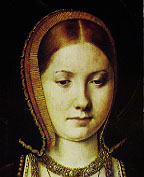
The French hood, obviously enough, had its origins in France. (find round hood picture) This painting of a young Katharine of Aragon shown to the left, created circa 1520, shows its origins-a veil similar to that worn by Margaret Beaufort shown in the section on English Gable hoods, but with a wired front which stiffened it into a round shape, rather than a pointed top.
The golden-colored, pleated band showing at the front of her veil remained an integral part of the french hood of the next two decades, but the construction, shape and silhouette of the rest changed drastically.
 Anne Boleyn is credited with introducing the French Hood into England. During her stay at the French court she adopted the contintental style, and continued to wear it upon her return to England. This portrait of Anne shown to the right depicts the classic early French Hood, as it was worn in England-closely fitting the head, covering the ears, with a gradual flare towards the back and the usual gold, pleated ribbon around the base. Whether this pleated ribbon is part of the hood or part of a coif worn beneath the hood is unknown. The French hood is obviously a separate item, and not a folded back section of the veil worn with it. A row of pearls decorates the top and bottom edges of the hood.
Anne Boleyn is credited with introducing the French Hood into England. During her stay at the French court she adopted the contintental style, and continued to wear it upon her return to England. This portrait of Anne shown to the right depicts the classic early French Hood, as it was worn in England-closely fitting the head, covering the ears, with a gradual flare towards the back and the usual gold, pleated ribbon around the base. Whether this pleated ribbon is part of the hood or part of a coif worn beneath the hood is unknown. The French hood is obviously a separate item, and not a folded back section of the veil worn with it. A row of pearls decorates the top and bottom edges of the hood.
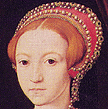 Known as "billiments" by the people of the time, these decorative jeweled and pearled edges were, though not essential, a fashionable addition to a plain french hood. Billiments sometimes matched the jeweled edging of a gown; indeed, the portrait of Queen Elizabeth as a young girl shown to the left, painted in 1545, shows her wearing a french hood of the same fabric of her gown as well. This, however, is not the case with most portraits; the overwhelming majority of french hoods were black, apparantly of satin, taffeta or perhaps velvet, with at most an edging of white fabric along the top or bottom.
Known as "billiments" by the people of the time, these decorative jeweled and pearled edges were, though not essential, a fashionable addition to a plain french hood. Billiments sometimes matched the jeweled edging of a gown; indeed, the portrait of Queen Elizabeth as a young girl shown to the left, painted in 1545, shows her wearing a french hood of the same fabric of her gown as well. This, however, is not the case with most portraits; the overwhelming majority of french hoods were black, apparantly of satin, taffeta or perhaps velvet, with at most an edging of white fabric along the top or bottom.
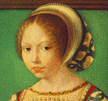 A black veil was attached to the inside back of the hood, where it fell to below the shoulders. Various interpretations of this veil shape have been used by re-enactors; some prefer a semi-circular veil, while others use a rectangular shape. There is evidence that bags as well as veils could be attached to the hood, though the only depictions of this are of young children like the one shown to the right. (see Hairnets, Cauls & Snoods for more information.)
A black veil was attached to the inside back of the hood, where it fell to below the shoulders. Various interpretations of this veil shape have been used by re-enactors; some prefer a semi-circular veil, while others use a rectangular shape. There is evidence that bags as well as veils could be attached to the hood, though the only depictions of this are of young children like the one shown to the right. (see Hairnets, Cauls & Snoods for more information.)
When the french hood first appeared in portraits of the nobility, its shape was not radically dissimilar to that of the transitional English hood-it was pretty much the same shape, but wired into a round rather than square silhouette. When experimenting with patterns for Square and French hoods, I found that an identical pattern with only miniscule changes could make both.
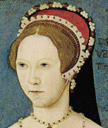
 As it gained in popularity, however, the shape of the french hood evolved-the tips of the hood narrowed into points and the side curve grew more pronounced, allowing the wearer to arrange her hair into poufs at either side of her head as the young princess Elizabeth does in the portrait shown above. The fashionable variety in french hoods was much greater than that of the preceding gable hood; not only the fabric and decoration of french hoods differed from piece to piece, but the shape of the wired base could be changed as well to create different profiles. Queen Mary, for instance, wore a french hood with a round profile when younger (shown to the left), but in later years favored one with a flatter top (shown to the right).
As it gained in popularity, however, the shape of the french hood evolved-the tips of the hood narrowed into points and the side curve grew more pronounced, allowing the wearer to arrange her hair into poufs at either side of her head as the young princess Elizabeth does in the portrait shown above. The fashionable variety in french hoods was much greater than that of the preceding gable hood; not only the fabric and decoration of french hoods differed from piece to piece, but the shape of the wired base could be changed as well to create different profiles. Queen Mary, for instance, wore a french hood with a round profile when younger (shown to the left), but in later years favored one with a flatter top (shown to the right).
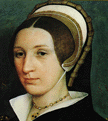 Katharine Howard, King Henry's fifth wife, is painted in a late Tudor (1540s) French hood which looks quite different from the hood worn by Anne Boleyn. It is white, and has a much curvier shape. It shows a strap underneath Katharine's chin keeping the hood on. Other portraits show no strap; whether the omission is artistic license, or the product of an as-yet-unknown method of keeping hoods in place, is still a mystery.
Katharine Howard, King Henry's fifth wife, is painted in a late Tudor (1540s) French hood which looks quite different from the hood worn by Anne Boleyn. It is white, and has a much curvier shape. It shows a strap underneath Katharine's chin keeping the hood on. Other portraits show no strap; whether the omission is artistic license, or the product of an as-yet-unknown method of keeping hoods in place, is still a mystery.
The hood worn by the older queen Mary, depicted above, was of a type popular during the 1550s. As you an see, the shape has changed still more. It is shorter and flatter, and the sides have broadened considerably from their original narrow point.

 By the time Queen Elizabeth was firmly ensconced upon the throne of England, the headwear of the well-to-do and the nobility had changed dramatically. The hood, now sometimes referred entirely as a "billiment" as well as a french hood, shrank even more in the 1560s and 1570s into a delicate arrangement of lace, jewelry, pearls, and fabric placed far back on the crown of the head. To the left is a portrait of Queen Elizabeth painted in the 1570s, showing such a billiment; to the right is a detail of another noblewoman's portrait, painted in 1560s, showing a similar item of headwear. The jeweled decorations grew in size and complexity, while the body of the hood is mostly hidden by bouffant hair and the decorative edgings.
By the time Queen Elizabeth was firmly ensconced upon the throne of England, the headwear of the well-to-do and the nobility had changed dramatically. The hood, now sometimes referred entirely as a "billiment" as well as a french hood, shrank even more in the 1560s and 1570s into a delicate arrangement of lace, jewelry, pearls, and fabric placed far back on the crown of the head. To the left is a portrait of Queen Elizabeth painted in the 1570s, showing such a billiment; to the right is a detail of another noblewoman's portrait, painted in 1560s, showing a similar item of headwear. The jeweled decorations grew in size and complexity, while the body of the hood is mostly hidden by bouffant hair and the decorative edgings.
French hoods were worn from 1530 to 1580 and were one of the longest-lasting types of headwear of the 16th century. Though the shape evolved greatly, the basic construction remained the same. French hoods, however, were not the only form of headwear worn by women after the English Gable Hood went out of style; the flat cap was also popular, with both women and men, through much of the 16th century.
Constructing a French Hood
Home
 Anne Boleyn is credited with introducing the French Hood into England. During her stay at the French court she adopted the contintental style, and continued to wear it upon her return to England. This portrait of Anne shown to the right depicts the classic early French Hood, as it was worn in England-closely fitting the head, covering the ears, with a gradual flare towards the back and the usual gold, pleated ribbon around the base. Whether this pleated ribbon is part of the hood or part of a coif worn beneath the hood is unknown. The French hood is obviously a separate item, and not a folded back section of the veil worn with it. A row of pearls decorates the top and bottom edges of the hood.
Anne Boleyn is credited with introducing the French Hood into England. During her stay at the French court she adopted the contintental style, and continued to wear it upon her return to England. This portrait of Anne shown to the right depicts the classic early French Hood, as it was worn in England-closely fitting the head, covering the ears, with a gradual flare towards the back and the usual gold, pleated ribbon around the base. Whether this pleated ribbon is part of the hood or part of a coif worn beneath the hood is unknown. The French hood is obviously a separate item, and not a folded back section of the veil worn with it. A row of pearls decorates the top and bottom edges of the hood.

 Known as "billiments" by the people of the time, these decorative jeweled and pearled edges were, though not essential, a fashionable addition to a plain french hood. Billiments sometimes matched the jeweled edging of a gown; indeed, the portrait of Queen Elizabeth as a young girl shown to the left, painted in 1545, shows her wearing a french hood of the same fabric of her gown as well. This, however, is not the case with most portraits; the overwhelming majority of french hoods were black, apparantly of satin, taffeta or perhaps velvet, with at most an edging of white fabric along the top or bottom.
Known as "billiments" by the people of the time, these decorative jeweled and pearled edges were, though not essential, a fashionable addition to a plain french hood. Billiments sometimes matched the jeweled edging of a gown; indeed, the portrait of Queen Elizabeth as a young girl shown to the left, painted in 1545, shows her wearing a french hood of the same fabric of her gown as well. This, however, is not the case with most portraits; the overwhelming majority of french hoods were black, apparantly of satin, taffeta or perhaps velvet, with at most an edging of white fabric along the top or bottom.
 A black veil was attached to the inside back of the hood, where it fell to below the shoulders. Various interpretations of this veil shape have been used by re-enactors; some prefer a semi-circular veil, while others use a rectangular shape. There is evidence that bags as well as veils could be attached to the hood, though the only depictions of this are of young children like the one shown to the right. (see
A black veil was attached to the inside back of the hood, where it fell to below the shoulders. Various interpretations of this veil shape have been used by re-enactors; some prefer a semi-circular veil, while others use a rectangular shape. There is evidence that bags as well as veils could be attached to the hood, though the only depictions of this are of young children like the one shown to the right. (see 
 As it gained in popularity, however, the shape of the french hood evolved-the tips of the hood narrowed into points and the side curve grew more pronounced, allowing the wearer to arrange her hair into poufs at either side of her head as the young princess Elizabeth does in the portrait shown above. The fashionable variety in french hoods was much greater than that of the preceding gable hood; not only the fabric and decoration of french hoods differed from piece to piece, but the shape of the wired base could be changed as well to create different profiles. Queen Mary, for instance, wore a french hood with a round profile when younger (shown to the left), but in later years favored one with a flatter top (shown to the right).
As it gained in popularity, however, the shape of the french hood evolved-the tips of the hood narrowed into points and the side curve grew more pronounced, allowing the wearer to arrange her hair into poufs at either side of her head as the young princess Elizabeth does in the portrait shown above. The fashionable variety in french hoods was much greater than that of the preceding gable hood; not only the fabric and decoration of french hoods differed from piece to piece, but the shape of the wired base could be changed as well to create different profiles. Queen Mary, for instance, wore a french hood with a round profile when younger (shown to the left), but in later years favored one with a flatter top (shown to the right).
 Katharine Howard, King Henry's fifth wife, is painted in a late Tudor (1540s) French hood which looks quite different from the hood worn by Anne Boleyn. It is white, and has a much curvier shape. It shows a strap underneath Katharine's chin keeping the hood on. Other portraits show no strap; whether the omission is artistic license, or the product of an as-yet-unknown method of keeping hoods in place, is still a mystery.
Katharine Howard, King Henry's fifth wife, is painted in a late Tudor (1540s) French hood which looks quite different from the hood worn by Anne Boleyn. It is white, and has a much curvier shape. It shows a strap underneath Katharine's chin keeping the hood on. Other portraits show no strap; whether the omission is artistic license, or the product of an as-yet-unknown method of keeping hoods in place, is still a mystery.

 By the time Queen Elizabeth was firmly ensconced upon the throne of England, the headwear of the well-to-do and the nobility had changed dramatically. The hood, now sometimes referred entirely as a "billiment" as well as a french hood, shrank even more in the 1560s and 1570s into a delicate arrangement of lace, jewelry, pearls, and fabric placed far back on the crown of the head. To the left is a portrait of Queen Elizabeth painted in the 1570s, showing such a billiment; to the right is a detail of another noblewoman's portrait, painted in 1560s, showing a similar item of headwear. The jeweled decorations grew in size and complexity, while the body of the hood is mostly hidden by bouffant hair and the decorative edgings.
By the time Queen Elizabeth was firmly ensconced upon the throne of England, the headwear of the well-to-do and the nobility had changed dramatically. The hood, now sometimes referred entirely as a "billiment" as well as a french hood, shrank even more in the 1560s and 1570s into a delicate arrangement of lace, jewelry, pearls, and fabric placed far back on the crown of the head. To the left is a portrait of Queen Elizabeth painted in the 1570s, showing such a billiment; to the right is a detail of another noblewoman's portrait, painted in 1560s, showing a similar item of headwear. The jeweled decorations grew in size and complexity, while the body of the hood is mostly hidden by bouffant hair and the decorative edgings.